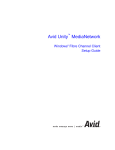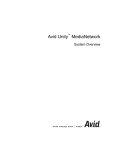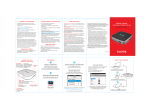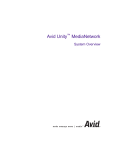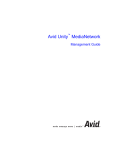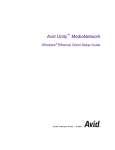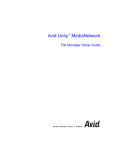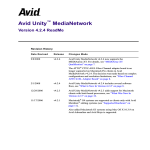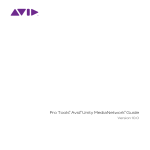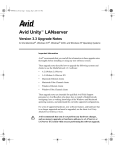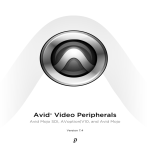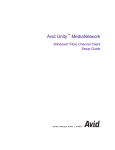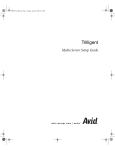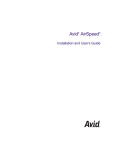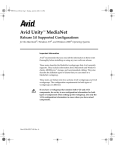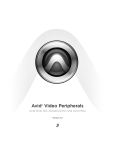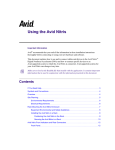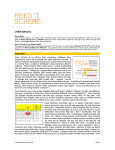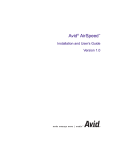Download Avid Unity MediaNetwork MEDIArray ZX4
Transcript
Avid™ Unity MediaNetwork MEDIArray ZX4 Setup Guide m a k e m a n a g e m ove | m e d i a ™ Avid ® Copyright and Disclaimer Product specifications are subject to change without notice and do not represent a commitment on the part of Avid Technology, Inc. The software described in this document is furnished under a license agreement. You can obtain a copy of that license by visiting Avid's Web site at www.avid.com. The terms of that license are also available in the product in the same directory as the software. The software may not be reverse assembled and may be used or copied only in accordance with the terms of the license agreement. It is against the law to copy the software on any medium except as specifically allowed in the license agreement. Avid products or portions thereof are protected by one or more of the following United States Patents: 4,746,994; 4,970,663; 5,045,940; 5,267,351; 5,309,528; 5,355,450; 5,396,594; 5,440,348; 5,452,378; 5,467,288; 5,513,375; 5,528,310; 5,557,423; 5,577,190; 5,584,006; 5,640,601; 5,644,364; 5,654,737; 5,715,018; 5,724,605; 5,726,717; 5,729,673; 5,745,637; 5,752,029; 5,754,851; 5,799,150; 5,812,216; 5,828,678; 5,842,014; 5,852,435; 5,987,501; 6,223,211; 6,301,105; 6,546,190; 6,636,869. Other patents are pending. No part of this document may be reproduced or transmitted in any form or by any means, electronic or mechanical, including photocopying and recording, for any purpose without the express written permission of Avid Technology, Inc. Copyright © 2004 Avid Technology, Inc. and its licensors. All rights reserved. Printed in USA. The following disclaimer is required byGenivia inc. "Part of the software embedded in this product is gSOAP software. Portions created by gSOAP are Copyright (C) 2001-2004 Robert A. van Engelen, Genivia inc. All Rights Reserved. THE SOFTWARE IN THIS PRODUCT WAS IN PART PROVIDED BY GENIVIA INC AND ANY EXPRESS OR IMPLIED WARRANTIES, INCLUDING, BUT NOT LIMITED TO, THE IMPLIED WARRANTIES OF MERCHANTABILITY AND FITNESS FOR A PARTICULAR PURPOSE ARE DISCLAIMED. IN NO EVENT SHALL THE AUTHOR BE LIABLE FOR ANY DIRECT, INDIRECT, INCIDENTAL, SPECIAL, EXEMPLARY, OR CONSEQUENTIAL DAMAGES (INCLUDING, BUT NOT LIMITED TO, PROCUREMENT OF SUBSTITUTE GOODS OR SERVICES; LOSS OF USE, DATA, OR PROFITS; OR BUSINESS INTERRUPTION) HOWEVER CAUSED AND ON ANY THEORY OF LIABILITY, WHETHER IN CONTRACT, STRICT LIABILITY, OR TORT (INCLUDING NEGLIGENCE OR OTHERWISE) ARISING IN ANY WAY OUT OF THE USE OF THIS SOFTWARE, EVEN IF ADVISED OF THE POSSIBILITY OF SUCH DAMAGE." The following disclaimer is required by Apple Computer, Inc. APPLE COMPUTER, INC. MAKES NO WARRANTIES WHATSOEVER, EITHER EXPRESS OR IMPLIED, REGARDING THIS PRODUCT, INCLUDING WARRANTIES WITH RESPECT TO ITS MERCHANTABILITY OR ITS FITNESS FOR ANY PARTICULAR PURPOSE. THE EXCLUSION OF IMPLIED WARRANTIES IS NOT PERMITTED BY SOME STATES. THE ABOVE EXCLUSION MAY NOT APPLY TO YOU. THIS WARRANTY PROVIDES YOU WITH SPECIFIC LEGAL RIGHTS. THERE MAY BE OTHER RIGHTS THAT YOU MAY HAVE WHICH VARY FROM STATE TO STATE. The following disclaimer is required by Sam Leffler and Silicon Graphics, Inc. for the use of their TIFF library: Copyright © 1988–1997 Sam Leffler Copyright © 1991–1997 Silicon Graphics, Inc. Permission to use, copy, modify, distribute, and sell this software [i.e., the TIFF library] and its documentation for any purpose is hereby granted without fee, provided that (i) the above copyright notices and this permission notice appear in all copies of the software and related documentation, and (ii) the names of Sam Leffler and Silicon Graphics may not be used in any advertising or publicity relating to the software without the specific, prior written permission of Sam Leffler and Silicon Graphics. 2 THE SOFTWARE IS PROVIDED “AS-IS” AND WITHOUT WARRANTY OF ANY KIND, EXPRESS, IMPLIED OR OTHERWISE, INCLUDING WITHOUT LIMITATION, ANY WARRANTY OF MERCHANTABILITY OR FITNESS FOR A PARTICULAR PURPOSE. IN NO EVENT SHALL SAM LEFFLER OR SILICON GRAPHICS BE LIABLE FOR ANY SPECIAL, INCIDENTAL, INDIRECT OR CONSEQUENTIAL DAMAGES OF ANY KIND, OR ANY DAMAGES WHATSOEVER RESULTING FROM LOSS OF USE, DATA OR PROFITS, WHETHER OR NOT ADVISED OF THE POSSIBILITY OF DAMAGE, AND ON ANY THEORY OF LIABILITY, ARISING OUT OF OR IN CONNECTION WITH THE USE OR PERFORMANCE OF THIS SOFTWARE. The following disclaimer is required by the Independent JPEG Group: Portions of this software are based on work of the Independent JPEG Group. The following disclaimer is required by Paradigm Matrix: Portions of this software licensed from Paradigm Matrix. The following disclaimer is required by Ray Sauers Associates, Inc.: “Install-It” is licensed from Ray Sauers Associates, Inc. End-User is prohibited from taking any action to derive a source code equivalent of “Install-It,” including by reverse assembly or reverse compilation, Ray Sauers Associates, Inc. shall in no event be liable for any damages resulting from reseller’s failure to perform reseller’s obligation; or any damages arising from use or operation of reseller’s products or the software; or any other damages, including but not limited to, incidental, direct, indirect, special or consequential Damages including lost profits, or damages resulting from loss of use or inability to use reseller’s products or the software for any reason including copyright or patent infringement, or lost data, even if Ray Sauers Associates has been advised, knew or should have known of the possibility of such damages. The following disclaimer is required by Videomedia, Inc.: “Videomedia, Inc. makes no warranties whatsoever, either express or implied, regarding this product, including warranties with respect to its merchantability or its fitness for any particular purpose.” The following disclaimer is required by Altura Software, Inc. for the use of its Mac2Win software and Sample Source Code: ©1993–1998 Altura Software, Inc. Attn. Government User(s). Restricted Rights Legend U.S. GOVERNMENT RESTRICTED RIGHTS. This Software and its documentation are “commercial computer software” or “commercial computer software documentation.” In the event that such Software or documentation is acquired by or on behalf of a unit or agency of the U.S. Government, all rights with respect to this Software and documentation are subject to the terms of the License Agreement, pursuant to FAR §12.212(a) and/or DFARS §227.7202-1(a), as applicable. Trademarks 888 I/O, Adrenaline, AirPlay, AirSPACE, AirSPACE HD, AniMatte, AudioSuite, AudioVision, AutoSync, Avid, Avid DNA, AVIDdrive, AVIDdrive Towers, Avid Mojo, AvidNet, AvidNetwork, AVIDstripe, Avid Unity, Avid Xpress, AVoption, AVX, CamCutter, ChromaCurve, ChromaWheel, DAE, D-Fi, D-fx, Digidesign, Digidesign Audio Engine, Digidesign Intelligent Noise Reduction, DigiDrive, Digital Nonlinear Accelerator, DigiTranslator, DINR, D-Verb, Equinox, ExpertRender, FieldPak, Film Composer, FilmScribe, FluidMotion, HIIP, HyperSPACE, HyperSPACE HDCAM, IllusionFX, Image Independence, Intraframe, iS9, iS18, iS23, iS36, Lo-Fi, Magic Mask, make manage move | media, Marquee, Matador, Maxim, MCXpress, Media Composer, MediaDock, MediaDock Shuttle, Media Fusion, Media Illusion, MediaLog, Media Reader, Media Recorder, MEDIArray, MediaShare, Meridien, MetaSync, NaturalMatch, Nearchive, NetReview, NewsCutter, Nitris, OMF, OMF Interchange, OMM, Open Media Framework, Open Media Management, ProEncode, Pro Tools, QuietDrive, Recti-Fi, RetroLoop, rS9, rS18, Sci-Fi, Softimage, Sound Designer II, SPACE, SPACEShift, Symphony, the Avid|DS logo, Trilligent, UnityRAID, Vari-Fi, Video Slave Driver, VideoSPACE, and Xdeck are either registered trademarks or trademarks of Avid Technology, Inc. in the United States and/or other countries. iNEWS, iNEWS ControlAir, and Media Browse are trademarks of iNews, LLC. 3 Asanté and FriendlyNET are registered trademarks; IntraCore is a trademark of Asanté Technologies, Inc. ATTO is a trademark of ATTO Technology, Inc. Ghost is a registered trademark of Symantec Corporation in the United States and other countries. Hyperterminal is a registered trademark of Hilgraveve, Inc. Macintosh is a trademark of Apple Computer, Inc., registered in the U.S. and other countries. Microsoft, Windows, Windows NT, and Windows 2000 are either registered trademarks or trademarks of Microsoft Corporation in the United States and/or other countries. SAN InSite is a trademark of Vixel Corporation. ScheduALL is a trademark of VizuALL, Inc. Avid Unity MediaNetwork MEDIArray ZX4 Setup Guide• Part 0130-07142-01 Rev. A • June 2005 4 Contents Using This Guide. . . . . . . . . . . . . . . . . . . . . . . . . . . . . . . . . . . . . . . . 3 Symbols and Conventions . . . . . . . . . . . . . . . . . . . . . . . . . . . . . . . . . . . . . . . 4 If You Need Help . . . . . . . . . . . . . . . . . . . . . . . . . . . . . . . . . . . . . . . . . . . . . . . 5 How to Order Documentation . . . . . . . . . . . . . . . . . . . . . . . . . . . . . . . . . . . . . 5 Avid Educational Services. . . . . . . . . . . . . . . . . . . . . . . . . . . . . . . . . . . . . . . . 6 Related Information . . . . . . . . . . . . . . . . . . . . . . . . . . . . . . . . . . . . . . . . . . . . . 6 Chapter 1 Installing a MEDIArray ZX4 Drive Enclosure . . . . . . . . . . . . . . . . . 7 Naming the MEDIArray ZX4 . . . . . . . . . . . . . . . . . . . . . . . . . . . . . . . . . . . . . . 8 Before You Begin . . . . . . . . . . . . . . . . . . . . . . . . . . . . . . . . . . . . . . . . . . . . . . 8 Configuring the MEDIArray ZX4 With Other Avid Storage Enclosures . . 8 MEDIArray ZX4 Components . . . . . . . . . . . . . . . . . . . . . . . . . . . . . . . . . . 9 MEDIArray ZX4 Hardware Overview. . . . . . . . . . . . . . . . . . . . . . . . . . . . . . . 10 MEDIArray ZX4 Front Panel. . . . . . . . . . . . . . . . . . . . . . . . . . . . . . . . . . 10 MEDIArray ZX4 Rear Panel . . . . . . . . . . . . . . . . . . . . . . . . . . . . . . . . . . 12 Installation Overview . . . . . . . . . . . . . . . . . . . . . . . . . . . . . . . . . . . . . . . . . . . 13 Installing the MEDIArray ZX4 Hardware . . . . . . . . . . . . . . . . . . . . . . . . . . . . 14 Installing the Second Fibre Channel Board . . . . . . . . . . . . . . . . . . . . . . 14 Installing on a Desktop . . . . . . . . . . . . . . . . . . . . . . . . . . . . . . . . . . . . . . 16 Installing the MEDIArray ZX4 . . . . . . . . . . . . . . . . . . . . . . . . . . . . . 16 Connecting Power Cords. . . . . . . . . . . . . . . . . . . . . . . . . . . . . . . . . 16 Installing in a Rack . . . . . . . . . . . . . . . . . . . . . . . . . . . . . . . . . . . . . . . . . 17 Installing the MEDIArray ZX4 Rack-Mount Rails . . . . . . . . . . . . . . . 17 Mounting a MEDIArray ZX4. . . . . . . . . . . . . . . . . . . . . . . . . . . . . . . 18 Connecting Power Cords. . . . . . . . . . . . . . . . . . . . . . . . . . . . . . . . . 18 Installing the MEDIArray ZX4 Drives . . . . . . . . . . . . . . . . . . . . . . . . . . . 19 Connecting the MEDIArray ZX4 to a Unity MediaNetwork System . . . . 20 Configuring Considerations for MEDIArray ZX4 . . . . . . . . . . . . . . . 22 Connecting One MEDIArray ZX4 to Two 2-Gb MEDIASwitch 16-4Gbs 23 Looping Two MEDIArray ZX4s to One 2-Gb MEDIASwitch 16-4Gb 24 Looping Two MEDIArray ZX4s to Two 2-Gb MEDIASwitch 16-4Gbs. . 25 Turning On the MEDIArray ZX4 Hardware. . . . . . . . . . . . . . . . . . . . . . . . . . 26 Chapter 2 Removing and Replacing MEDIArray ZX4 Drives. . . . . . . . . . . . . 27 Drive Management Overview . . . . . . . . . . . . . . . . . . . . . . . . . . . . . . . . . . . . 28 Identifying Bad Drives . . . . . . . . . . . . . . . . . . . . . . . . . . . . . . . . . . . . . . . . . 28 Using the Disk Error Analyzer . . . . . . . . . . . . . . . . . . . . . . . . . . . . . . . . 29 Using the MEDIArray ZX Viewer . . . . . . . . . . . . . . . . . . . . . . . . . . . . . . 30 Selecting Events to View . . . . . . . . . . . . . . . . . . . . . . . . . . . . . . . . 30 Filtering Events . . . . . . . . . . . . . . . . . . . . . . . . . . . . . . . . . . . . . . . . 31 Detecting Slow Drives. . . . . . . . . . . . . . . . . . . . . . . . . . . . . . . . . . . 32 Replacing the Data Drive Set . . . . . . . . . . . . . . . . . . . . . . . . . . . . . . . . . . . . 36 How Online Drive Recovery Works . . . . . . . . . . . . . . . . . . . . . . . . . . . . 36 Recovering and Replacing a Drive Online . . . . . . . . . . . . . . . . . . . . . . . . . . 37 Appendix A Using the Product Recovery CD-ROM. . . . . . . . . . . . . . . . . . . . . . 41 Reinstalling the MEDIArray ZX4 Software Components . . . . . . . . . . . . . . . 42 Appendix B MEDIArray ZX4 Specifications and Notices . . . . . . . . . . . . . . . . . 45 Dimensions and Weight . . . . . . . . . . . . . . . . . . . . . . . . . . . . . . . . . . . . . . . . 46 Environment . . . . . . . . . . . . . . . . . . . . . . . . . . . . . . . . . . . . . . . . . . . . . . . . . 46 Electrical. . . . . . . . . . . . . . . . . . . . . . . . . . . . . . . . . . . . . . . . . . . . . . . . . . . . 46 Power Cords. . . . . . . . . . . . . . . . . . . . . . . . . . . . . . . . . . . . . . . . . . . . . . . . . 47 Installing a MEDIArray ZX4 in a Rack . . . . . . . . . . . . . . . . . . . . . . . . . . . . . 48 MEDIArray ZX4 Lithium Battery Replacement . . . . . . . . . . . . . . . . . . . . . . . 49 2 Appendix C Legacy, Supported MEDIArray ZX Configurations . . . . . . . . . . . 51 Connecting the MEDIArray ZX to a Unity MediaNetwork System. . . . . . . . . 52 Configuring Considerations . . . . . . . . . . . . . . . . . . . . . . . . . . . . . . . . . . . . . . 54 Connecting One MEDIArray ZX to Two 1-Gb MEDIASwitches . . . . . . . 55 Looping Two MEDIArray ZXs to One 1-Gb MEDIASwitch . . . . . . . . . . . 56 Looping Two MEDIArray ZXs to Two 1-Gb MEDIASwitches . . . . . . . . . 57 Connecting One MEDIArray ZX to Two 2-Gb MEDIASwitches . . . . . . . 58 Looping Two MEDIArray ZXs to One 2-Gb MEDIASwitch . . . . . . . . . . . 59 Looping Two MEDIArray ZXs to Two 2-Gb MEDIASwitches . . . . . . . . . 60 Appendix D Regulatory and Safety Notices . . . . . . . . . . . . . . . . . . . . . . . . . . . 61 Warnings and Cautions . . . . . . . . . . . . . . . . . . . . . . . . . . . . . . . . . . . . . . . . . 61 FCC Notice . . . . . . . . . . . . . . . . . . . . . . . . . . . . . . . . . . . . . . . . . . . . . . . . . . 61 Canadian ICES-003 . . . . . . . . . . . . . . . . . . . . . . . . . . . . . . . . . . . . . . . . . . . 62 European Union Notice . . . . . . . . . . . . . . . . . . . . . . . . . . . . . . . . . . . . . . . . . 62 Australia and New Zealand EMC Regulations . . . . . . . . . . . . . . . . . . . . . . . 64 Taiwan EMC Regulations . . . . . . . . . . . . . . . . . . . . . . . . . . . . . . . . . . . . . . . 64 Index . . . . . . . . . . . . . . . . . . . . . . . . . . . . . . . . . . . . . . . . . . . . . . . . . 65 3 Illustrations MEDIArray ZX4 with Front Door Closed . . . . . . . . . . . . . . . . . . . . . . . . . . . . 10 MEDIArray ZX4 with Front Door Open. . . . . . . . . . . . . . . . . . . . . . . . . . . . . . 11 Hard Drive Carrier . . . . . . . . . . . . . . . . . . . . . . . . . . . . . . . . . . . . . . . . . . . . . 11 MEDIArray ZX4 Rear Panel . . . . . . . . . . . . . . . . . . . . . . . . . . . . . . . . . . . . . . 12 Aligning the MEDIArray ZX4 Rails to the Rack . . . . . . . . . . . . . . . . . . . . . . . 17 16 Drive Configurations . . . . . . . . . . . . . . . . . . . . . . . . . . . . . . . . . . . . . . . . . 19 Proper Drive Orientation. . . . . . . . . . . . . . . . . . . . . . . . . . . . . . . . . . . . . . . . . 19 Installing the SFP in the MEDIASwitch 16-4Gb . . . . . . . . . . . . . . . . . . . . . . . 21 Port Layout for 4-Gb MEDIASwitch 16-4Gb. . . . . . . . . . . . . . . . . . . . . . . . . . 21 One MEDIArray ZX4 and Two 2-Gb MEDIASwitch 16-4Gbs. . . . . . . . . . . . . 23 Looping Two MEDIArray ZX4s to a 2-Gb MEDIASwitch 16-4Gb. . . . . . . . . . 24 Looping Two MEDIArray ZX4s to a 2-Gb MEDIASwitch 16-4Gb. . . . . . . . . . 25 MEDIArray ZX Event Viewer Window . . . . . . . . . . . . . . . . . . . . . . . . . . . . . . 30 Filter Events Dialog Box . . . . . . . . . . . . . . . . . . . . . . . . . . . . . . . . . . . . . . . . . 31 Avid Disk Error Analyzer Showing the New Errors. . . . . . . . . . . . . . . . . . . . . 34 Receptacle (CEE-22) . . . . . . . . . . . . . . . . . . . . . . . . . . . . . . . . . . . . . . . . . . . 47 NEMA 5-15P Style Plug . . . . . . . . . . . . . . . . . . . . . . . . . . . . . . . . . . . . . . . . . 48 Port Layout for 1-Gb MEDIASwitches . . . . . . . . . . . . . . . . . . . . . . . . . . . . . . 52 Port Layout for 2-Gb MEDIASwitches . . . . . . . . . . . . . . . . . . . . . . . . . . . . . . 53 One MEDIArray ZX and Two 1-Gb MEDIASwitches . . . . . . . . . . . . . . . . . . . 55 Looping Two MEDIArray ZXs to a 1-Gb MEDIASwitch . . . . . . . . . . . . . . . . . 56 Looping Two MEDIArray ZXs to Two 1-Gb MEDIASwitch . . . . . . . . . . . . . . . 57 One MEDIArray ZX and Two 2-Gb MEDIASwitches . . . . . . . . . . . . . . . . . . . 58 Looping Two MEDIArray ZXs to a 2-Gb MEDIASwitch . . . . . . . . . . . . . . . . . 59 Looping Two MEDIArray ZXs to a 2-Gb MEDIASwitch . . . . . . . . . . . . . . . . . 60 1 Tables Component Dimensions and Weight. . . . . . . . . . . . . . . . . . . . . . . . . . . . . . . 46 Environmental Specifications . . . . . . . . . . . . . . . . . . . . . . . . . . . . . . . . . . . . 46 Electrical Specifications . . . . . . . . . . . . . . . . . . . . . . . . . . . . . . . . . . . . . . . . 46 Power Cord Requirements . . . . . . . . . . . . . . . . . . . . . . . . . . . . . . . . . . . . . . 48 1 2 Using This Guide Congratulations on your purchase of an Avid MEDIArray™ ZX4. You can connect your Windows® 2000 or Macintosh® client to a MediaNetwork workgroup to share media files and other project data that have MEDIArray ZX4 enclosures connected. n Your MEDIArray ZX4 might not contain all the components or features described in your documentation. Avid documentation describes all components and features regardless of which configuration you purchased. This guide is intended for anyone who is installing, configuring, or maintaining a MEDIArray ZX4 enclosure. It provides installation and configuration information for the MEDIArray ZX4 hardware. Using This Guide Symbols and Conventions Avid documentation uses the following symbols and conventions: Symbol or Convention Meaning or Action n A note provides important related information, reminders, recommendations, and strong suggestions. c A caution means that a specific action you take could cause harm to your computer or cause you to lose data. w 4 A warning describes an action that could cause you physical harm. Follow the guidelines in this document or on the unit itself when handling electrical equipment. > This symbol indicates menu commands (and subcommands) in the order you select them. For example, File > Import means to open the File menu and then select the Import command. t This symbol indicates a single-step procedure. Multiple arrows in a list indicate that you perform one of the actions listed. k This symbol represents the Apple or Command key. Press and hold the Command key and another key to perform a keyboard shortcut. Margin tips In the margin, you will find tips that help you perform tasks more easily and efficiently. (Windows), (Windows only), (Macintosh), or (Macintosh only) This text indicates that the information applies only to the specified operating system, either Windows XP or Macintosh OS X. Italic font Italic font is used to emphasize certain words and to indicate variables. Courier Bold font Courier Bold font identifies text that you type. Ctrl+key or mouse action k+key or mouse action Press and hold the first key while you press the last key or perform the mouse action. For example, k+Option+C or Ctrl+drag. If You Need Help If You Need Help If you are having trouble using the MEDIArray ZX4: 1. Retry the action, carefully following the instructions given for that task in this guide. It is especially important to check each step of your workflow. 2. Check for the latest information that might have become available after the documentation was published in one of two locations: n - If release notes are available, they ship with your application. - If ReadMe files are available, they are supplied in your Avid application folder. ReadMe files are also available from Help. Release notes and ReadMe files are also available on the Avid Knowledge Center. 3. Check the documentation that came with your Avid application or your hardware for maintenance or hardware-related issues. 4. Visit the online Knowledge Center at www.avid.com/support. Online services are available 24 hours per day, 7 days per week. Search this online Knowledge Center to find answers, to view error messages, to access troubleshooting tips, to download updates, and to read/join online message-board discussions. 5. For Technical Support, please call 800-800-AVID (800-800-2843). For Broadcast On-Air Sites and Call Letter Stations, call 800-NEWSDNG (800-639-7364). How to Order Documentation To order additional copies of this documentation from within the United States, call Avid Sales at 800-949-AVID (800-949-2843). If you are placing an order from outside the United States, contact your local Avid representative. 5 Using This Guide Avid Educational Services For information on courses/schedules, training centers, certifications, courseware, and books, please visit www.avid.com/training or call Avid Sales at 800-949-AVID (800-949-2843). Related Information The following documents provide more information about the MediaNetwork environment, the MediaNetwork client, and other storage options: 6 • Avid Unity MediaNetwork Site Preparation Guide (Online only) • Avid Unity MediaNetwork File Manager Setup Guide • Avid Unity MediaNetwork File Manager Failover Installation Notes • Avid Unity MediaNetwork Upgrade Notes • Avid Unity MediaNetwork PortServer Setup Guide • Avid Unity MediaNetwork Media Server Setup Guide • Avid Unity MediaNetwork Supported Configurations • Avid Unity MediaNetwork System Overview • Avid Unity MediaNetwork Management Guide • MediaNetwork Macintosh Fibre Channel Client Quick Start Card • Avid Unity MediaNetwork Windows Fibre Channel Client Setup Guide • MediaNetwork Windows Fibre Channel Client Quick Start Card • Avid Unity MediaNetwork Macintosh Ethernet Client Setup Guide • MediaNetwork Macintosh Ethernet Client Quick Start Card • Avid Unity MediaNetwork Windows Ethernet Client Setup Guide • MediaNetwork Windows Ethernet Client Quick Start Card • Avid Unity MediaNetwork Release Notes Chapter 1 Installing a MEDIArray ZX4 Drive Enclosure This chapter describes how to install a MEDIArray™ ZX and connect it to a MEDIASwitch 16-4Gb. This manual assumes that you have the MEDIASwitch 16-4Gb with Small Form-Factor Pluggable (SFP) connectors already installed. n n The Avid Unity MediaNetwork software requirement when using the MEDIArray ZX3 or MEDIArray ZX4 is v3.5 or later. This chapter of the manual only explains the 2-Gb MediaSwith 16. Connections for the 9100 and 9200 MEDIASwitches and the 7X00 MEDIAswitches can be found in Appendix C Legacy, Supported MEDIArray ZX Configurations. Topics in this chapter include: • Before You Begin • MEDIArray ZX4 Hardware Overview • Installation Overview • Installing the MEDIArray ZX4 Hardware • Turning On the MEDIArray ZX4 Hardware Chapter 1 Installing a MEDIArray ZX4 Drive Enclosure Naming the MEDIArray ZX4 There are three types of MEDIArray ZX eavailable in the field. There is the MEDIArray ZX2 (commonly refered to a MEDIArray ZX in the field), MEDIArray ZX3, and MEDIArray ZX4. The main differences (other than drivers and internal controllers) are: • MEDIArray ZX - a specific backplane and a 2 Gb ATTO Fibre Channel board. • MEDIArray ZX3 - A different backplane from the MEDIArray ZX but still containing the 2 Gb ATTO Fibre Channel board. • MEDIArray ZX4 - The same backplane as in the MEDIArray ZX3 but containing a new ghost image for the system and a new 4 Gb ATTO Fibre Channel board. The MEDIArray ZX enclosures have a different Part Numbers and a sticker (MZX-3 or MZX-4) located on the upper right front panel. See “MEDIArray ZX4 with Front Door Open” on page 11 for the location of the sticker. Before You Begin Keep the shipping boxes that come with your MEDIArray ZX4 kit. You might need to repackage and ship the components in the future. Before you begin to install the MEDIArray ZX4 hardware, do the following: • Check existing MEDIArray ZX4 configurations on your Unity MediaNetwork. • Unpack the MEDIArray ZX4 kit. • Unpack drives. • Check the contents of the kit against the packing sticker on the outside of each shipping box to confirm you have received all the components. Configuring the MEDIArray ZX4 With Other Avid Storage Enclosures The MEDIArray ZX4 can be configured on the same Unity MediaNetwork with other Avid storage enclosures, such as MEDIArray ZX3, MEDIArray ZX, MEDIArray II and MEDIArray, if you use the following guidelines: 8 Before You Begin • You must create a new allocation group for the MEDIArray ZX4 enclosures. • You cannot loop unlike enclosures together. For example: you cannot loop a MEDIArray ZX3 enclosure with a MEDIArray II enclosure. • You can loop a MEDIArray ZX with a MEDIArray ZX3 since they are both 2 Gb. • You cannot loop a MEDIArray ZX3 and a MEDIArray ZX4 since they are 2 Gb and 4 Gb devices. • If you are using a 2-Gb File Manager, the maximum number of disks you can use in a mixed enclosure configuration remains at 96. For more configuration information see the setup guide for the specific enclosure and the Avid Unity MediaNetwork Management Guide. MEDIArray ZX4 Components A MEDIArray ZX4 works with either one or two Fibre Channel boards. The following list explains what you would receive depending upon your order: • A MEDIArray ZX4 chassis with one ATTO 2-Gb Fibre Channel board • A second Fibre Channel board shipped separately if you ordered a MEDIArray ZX4 with two Fibre Channel boards • 16 drives (shipped separately) • Two power cables • Keys for the drives and the front panel • Rail kit for rack-mounting and rubber feet for Desktop mounting only • A MEDIArray ZX4 Recovery CD-ROM and a Windows 2000 Professional Operating system Software kit. • A mix of the following specific cables you ordered for your site: - 3 meter standard (duplex) LC-LC optical - 3 meter standard (duplex) LC-SC optical - Two 3 meter simplex LC-LC optical - Two 3 meter simplex LC-LC optical - Two .5 meter simplex LC-LC optical 9 Chapter 1 Installing a MEDIArray ZX4 Drive Enclosure MEDIArray ZX4 Hardware Overview The MEDIArray ZX4 is desktop or a rack-mount enclosure that contains 16 hard drives. The MEDIArray ZX4 connects to one or two MEDIASwitch 164Gbs and provides storage for systems that are connected to the Avid Unity™ MediaNetwork. The MEDIArray ZX4 can contain two ATTO 2-Gb optical Fibre Channel boards. There are two versions of the MEDIArray ZX enclosure, MEDIArray ZX and MEDIArray ZX4, and they are compatible. See the figure labeled “MEDIArray ZX4 with Front Door Open” on page 11. MEDIArray ZX4 Front Panel The front of the MEDIArray ZX4 has a single door (see figure “MEDIArray ZX4 with Front Door Closed”). The door can be locked to prevent access to the internal components while the MEDIArray ZX4 is running. Front door Door latch/lock Window for drive lights MEDIArray ZX4 with Front Door Closed The door covers the following components (see figure “MEDIArray ZX4 with Front Door Open” on page 11): 10 • 16 hard drives • CD-ROM drive • Power and Reset buttons • Cover hold-down screw MEDIArray ZX4 Hardware Overview When the door is open, it shows a sticker defining the type of MEDIArray ZX, a list of the drives, by number, to aid in drive identification for removal and replacement. Avid is now only shipping MEDIArray ZX4 systems. Reset button CD-ROM drive Cover hold-down screw Power button MZX-4 sticker Top drive MZX-4 Hard drives Open door Top drive 12 13 14 15 16 Top drive 7 8 9 10 11 Top drive 2 3 4 5 6 1 Drive ID number MEDIArray ZX4 with Front Door Open Each of the hard drives has a lock and a green and amber LED on the left side of the drive carrier (see figure “Hard Drive Carrier”). The lock can be used to secure the drive carrier, preventing its removal from the MEDIArray ZX4. The green LED is on when a drive is receiving power from the MEDIArray ZX4. The amber LED flashes when a drive is in use. n There is also a boot drive that is located inside the MEDIArray ZX4. Amber LED Green LED Lock Drive carrier latch Hard Drive Carrier 11 Chapter 1 Installing a MEDIArray ZX4 Drive Enclosure MEDIArray ZX4 Rear Panel The rear panel of the MEDIArray ZX4 (see figure “MEDIArray ZX4 Rear Panel”) is where the power cord connectors, and the Fibre Channel board connections are located. There are other connectors at the rear of the MEDIArray ZX4 that are not used. n The MEDIArray ZX looks the same as the MEDIArray ZX4, but the two Fibre Channel boards were located in PCI slots 3 and 4. Alarm Reset button Power cord connectors Cover hold-down screw Fibre Channel boards l PCI slots 1 and 2 contain internal 3Ware disk controllers for the 8 and 16 drives used for data storage l Power supply modules l On/Off switches 6 5 4 3 2 1 PCI Slots MEDIArray ZX4 Rear Panel c 12 The first Fibre Channel board should be in PCI slot 5 and the second Fibre Channel board (if ordered) should go into PCI slot 6. Installation Overview Installation Overview The MEDIArray ZX4 is connected to a MEDIASwitch 16-4Gb and is used by clients that are also attached to the Avid Unity MediaNetwork. The following list provides information you should know before you start the MEDIArray ZX4 installation: n n • The Avid Unity MediaNetwork software requirement when using the MEDIArray ZX4 is v3.5 or later. • The MEDIArray ZX4 uses only Fibre Channel optical boards. • Each MEDIArray ZX4 contains 16 Drives. • The MEDIArray ZX4 can be connected to either one or two MEDIASwitch 16-4Gbs. This chapter of the manual only explains the 2-Gb MEDIASwith 16. Connections for the 9100 and 9200 MEDIASwitches and the 7X00 MEDIAswitches can be found in Appendix C “Legacy, Supported MEDIArray ZX Configurations”. • You need one ATTO Fibre Channel board in the MEDIArray ZX4 for each MEDIASwitch 16-4Gb to which the MEDIArray ZX4 will connect. • Two MEDIArray ZX4 enclosures can be connected (looped) together and connected to one MEDIASwitch 16-4Gb. • When you have a File Manager with 3 GB of memory the maximum number of MEDIArray ZX4s is six enclosures with 16 drives. If you loop two MEDIArray ZX4 enclosures together you must use the simplex cables. See “MEDIArray ZX4 Hardware Overview” on page 10 and “Connecting the MEDIArray ZX4 to a Unity MediaNetwork System” on page 20. 13 Chapter 1 Installing a MEDIArray ZX4 Drive Enclosure Installing the MEDIArray ZX4 Hardware Each MEDIArray ZX4 ships with at least one Fibre Channel board in slot 5 and three power supplies installed. The following list describes what you need to do to install the MEDIArray ZX4. • Install the second Fibre Channel board, if needed, for dual switch configurations. • Perform either: • t Desktop installation t Rack-mount installation Install the MEDIArray ZX4 drives. Installing the Second Fibre Channel Board If you have dual switch configurations you need to install a second Fibre Channel board into PCI slot 6, if not, continue to “Installing on a Desktop” on page 16 or “Installing in a Rack” on page 17. Each Fibre Channel board allows you to connect to a different MEDIASwitch 16-4Gb. To install an additional board: 1. Open the MEDIArray ZX4 front door. 2. Loosen the cover hold-down screw at the top center of the front panel and rear panel. 3. Slide the cover back approximately 1-1/2 inches. 4. Lift the cover off of the enclosure. c Make sure you are wearing a grounding wrist strap that is attached to the metal of the enclosure before you continue. The boards are sensitive to electrostatic discharge. Do not handle boards unless you are properly grounded. 5. Remove the board retainer bar screw on the right side near the back of the enclosure. 6. Lift the right side of the board retainer bar up and pivot the bar to the left. The board retainer bar must be almost vertical on the left side of the enclosure to remove it. 14 Installing the MEDIArray ZX4 Hardware 7. Lift the board retainer bar out of the enclosure. 8. Remove the screw holding the PCI slot 4 cover in place. 9. Lift the slot cover out of the enclosure. 10. Locate the new board you are installing. 11. Remove the board from the antistatic bag. 12. Insert the board into the PCI slot 4 as shown in figure “MEDIArray ZX4 Rear Panel” on page 12. Make sure the slot cover aligns correctly. 13. Push the board into the slot. Make sure the board is seated completely in the slot. 14. Replace the slot cover screw to hold the new board in place. c Do not run the MEDIArray ZX4 without the board retainer bar. The board retainer bar ensures that the boards are seated properly in their slots. Running the MEDIArray ZX4 without the board retainer bar can cause intermittent problems. 15. Reinstall the board retainer bar. Make sure the drive controller boards are vertical. They must be in the left groove on the board hold-down arm when looking at the MEDIArray ZX4 from the front. 16. Align the board retainer bar and replace the board retainer bar screw. 17. To replace the cover, slide it onto the enclosure. 18. Secure the cover with the hold-down screw. 19. Close the MEDIArray ZX4 front door. The MEDIArray ZX4 hardware can be set on a desktop or mounted in a rack. Select one of the following: t If you are installing the MEDIArray ZX4 on a desktop, continue with “Installing on a Desktop” on page 16. t If you are installing the MEDIArray ZX4 in a rack, continue with “Installing in a Rack” on page 17. 15 Chapter 1 Installing a MEDIArray ZX4 Drive Enclosure Installing on a Desktop The following sections describe how to install the MEDIArray ZX4 on a desktop. Installing the MEDIArray ZX4 To install the MEDIArray ZX4 on a desktop: 1. Locate the rubber feet in the MEDIArray ZX4 kit. 2. Attach one rubber foot to the bottom of the MEDIArray ZX4 at each corner. 3. Place the MEDIArray ZX4 on the desktop. Leave adequate room at the front and rear for air circulation and access to drives, cables, and power supplies. Connecting Power Cords Before you attach the power cords to the MEDIArray ZX4 components, make sure the three Power switches on the MEDIArray ZX4 power modules are in the off (O) position. To connect the power cords to the MEDIArray ZX4: 1. Plug one power cord into the right power connector on the back of the MEDIArray ZX4. 2. Plug one power cord into the left power connector on the back of the MEDIArray ZX4. 3. Plug the power cords into power outlets. c 16 Do not turn on the MEDIArray ZX4 until the drives are installed. Installing the MEDIArray ZX4 Hardware Installing in a Rack The following sections describe how to install the MEDIArray ZX4 in a rack. Installing the MEDIArray ZX4 Rack-Mount Rails If you are installing the MEDIArray ZX4 in a rack, follow the instructions supplied in the MEDIArray ZX4 rail kit to install the rack-mount rails while ensuring that: • The rails do not interfere with the power strips, power cords, or other cables at the back of the rack. • The bottom of the MEDIArray ZX4 is at the bottom of a U-alignment space. • The rails span two U-alignment spaces and use the middle two slots for screws (see figure “Aligning the MEDIArray ZX4 Rails to the Rack”). • The rails allow the MEDIArray ZX4 to slide completely into the rack. • The front edge of the slides are set back approximately 1/2 inch from the rack front channels. • The rails attach as far forward on the MEDIArray ZX4 as possible. Rack channel hole spacing 1/2 in EIA rack unit 5/8 in 1 3/4 in 2U 5/8 in 1/2 in Baseline of MEDIArray ZX4is at U-alignment 1 3/4 in position between two 1/2-inch spaced holes. 1U 5/8 in 5/8 in 1/2 in Support rail Rack front channel Aligning the MEDIArray ZX4 Rails to the Rack 17 Chapter 1 Installing a MEDIArray ZX4 Drive Enclosure Mounting a MEDIArray ZX4 w Mounting the MEDIArray ZX4 on the rack-mount rails is a two-person task. It is heavy, fits tightly into the rack rails, and the rails might need to be spread slightly to fit the MEDIArray ZX4. If you try to mount the MEDIArray ZX4 alone, you might damage the MEDIArray ZX4 or injure yourself. To mount the MEDIArray ZX4 on the rack-mount rails: 1. Slide the rack-mount rails out of the rack until fully extended. 2. Lift the MEDIArray ZX4 into position with one person on each side of the rack. 3. Place the rail slides on the MEDIArray ZX4 onto the extended rails. 4. Slide the MEDIArray ZX4 into the rack. You should hear the slides click onto the rails as you push the MEDIArray ZX4 into the rack. Connecting Power Cords Before you attach the power cords to the MEDIArray ZX4 components, make sure the three Power switches on the MEDIArray ZX4 power modules are in the off (O) position. To connect the power cords to the MEDIArray ZX4 and other components: 1. Plug one power cord into the right power connector on the back of the MEDIArray ZX4. 2. Plug one power cord into the left power connector on the back of the MEDIArray ZX4. 3. Plug the power cords into power outlets. c 18 Do not turn on the MEDIArray ZX4 until the drives are installed. Installing the MEDIArray ZX4 Hardware Installing the MEDIArray ZX4 Drives Once the system has been installed on the desktop or in a rack you need to install the MEDIArray drives into the enclosure (see figure “16 Drive Configurations”). 16 Drive Configuration MZX-4 Drive one 16 Drive Configurations To install a drive in the MEDIArray ZX4: 1. Locate the drives that came with your MEDIArray ZX4. 2. Select one drive. 3. Push down on the left side of the purple handle and pull the handle forward from the drive carrier. 4. Make sure the drive has the lock on the left (or on top for drive one) before you begin to slide the drive into the enclosure. Locked Unlocked Horizontal (No locking mechanism on filler panels) Vertical Proper Drive Orientation n When you are installing drives in the MEDIArray ZX4, begin the installation at the bottom of a column of drives. Make sure the first drive you install is level and flat as you insert it into the enclosure. 19 Chapter 1 Installing a MEDIArray ZX4 Drive Enclosure c c Do not force a drive into a slot. If you are having problems installing a drive, check to make sure it is level and flat as you insert it into the enclosure, that the drive carrier latch is fully open, and that the lock on the left of the drive carrier is in the unlocked (down) position. If the drive insertion problem persists, check to see if the drive carrier is warped and replace it if needed. 5. Slide the drive into the open drive slot in the MEDIArray ZX4 until it stops moving. Approximately 1/2 inch of the drive carrier should be outside the MEDIArray ZX4. 6. Push the latch into the drive carrier. This seats the drive in the MEDIArray ZX4. You should hear a click when the drive is fully seated and the handle latches in place. 7. Repeat steps 2 to 6 for the remaining drives. Connecting the MEDIArray ZX4 to a Unity MediaNetwork System The MEDIASwitch 16-4Gb connects the MediaNetwork workgroup to several MediaNetwork clients. The switch allows the MediaNetwork clients to use the storage simultaneously. The switch prevents work interruptions by allowing other clients in the workgroup to continue working if one or more clients go offline. You connect the MEDIArray ZX4 to the Unity MediaNetwork system with one of the MEDIASwitch 16-4Gb 2-Gb switch. n You can use two 2-Gb switches to connect one or two MEDIArray ZX4s, but they must be the same type of switch. Avid supports the 9200 MediaSwitch (explained in Appendix A) but no longer ships the switch. You cannot use the 9200 and the MEDIASwitch 16-4Gb together with the same MEDIArray ZX4. The 2-Gb MEDIASwitch 16-4Gb (see figure “Installing the SFP in the MEDIASwitch 16-4Gb” on page 21) uses SFP connectors to connect the cables to the switch. n 20 Please note the position of the SFP. Make sure the optical connector is facing away from the MEDIASwitch 16-4Gb and the pull handle is on the top. Installing the MEDIArray ZX4 Hardware Installing the SFP in the MEDIASwitch 16-4Gb n This sections explains the 2-Gb MEDIASwitch 16-4Gb. If you are connecting a MEDIArray ZX4 to one of the older 7X00 or 9X00 MEDIAswitches see Appendix C Legacy, Supported MEDIArray ZX Configurations. MediaNetwork client ports Storage ports File Manager port Port 0 Port 15 MediaNetwork client ports Port Layout for 4-Gb MEDIASwitch 16-4Gb 21 Chapter 1 Installing a MEDIArray ZX4 Drive Enclosure Configuring Considerations for MEDIArray ZX4 When you connect a MEDIArray ZX4 to a Unity™ MediaNetwork you must take the following into consideration: • A MEDIArray ZX4 can connect to a maximum of two MEDIASwitch 164Gbs of the same speed and model. You cannot have a MediaSwitch 9X00 and a MEDIASwitch 16-4Gb in the same Avid Unity system. • If MEDIArray ZX4s are the only storage devices you are using, the maximum number of MEDIArray ZX4s per Unity system is six fully configured MEDIArray ZX4s. The MEDIArray ZX4s can be configured in the following ways: - One MEDIArray ZX4 connected to one MEDIASwitch 16-4Gb port (see the figure labeled “Port Layout for 4-Gb MEDIASwitch 16-4Gb” on page 21 for port connections). - One MEDIArray ZX4 connected to two MEDIASwitch 16-4Gbs. In a dual MEDIASwitch 16-4Gb environment each MEDIArray ZX4 would have two Fibre Channel boards. One board in PCI slot 5 and one board in PCI slot 6 (see “Connecting One MEDIArray ZX4 to Two 2-Gb MEDIASwitch 16-4Gbs” on page 23). - Two MEDIArray ZX4s (or a MEDIArray ZX4 and a MEDIArray ZX) can be looped together and connected to one MEDIAswitch port (see “Looping Two MEDIArray ZX4s to One 2-Gb MEDIASwitch 16-4Gb” on page 24). - Two MEDIArray ZX4s (or a MEDIArray ZX4 and a MEDIArray ZX) can be looped together and connected to two MEDIAswitch ports. In a dual MEDIASwitch 16-4Gb environment each MEDIArray ZX4 would have two Fibre Channel boards. One board in PCI slot 5 and one board in PCI slot 6. See “Looping Two MEDIArray ZX4s to Two 2-Gb MEDIASwitch 16-4Gbs” on page 25. The type of cable you use depends upon the type of switch and the MEDIArray ZX4 configuration used. The following cable information should be taken into consideration: 22 • If you are installing the optical cable for use with a 2-Gb MEDIASwitch 16-4Gb, the cable needs LC optical cable connectors at both ends. • If you are looping two MEDIArray ZX4 enclosures to a MEDIASwitch 16-4Gb you need three simplex cables. Two simplex cables 3 meters in length and one simplex cable .5 meters in length. The type of ends on the 3 meter cables depend upon the switch you are connecting to. Installing the MEDIArray ZX4 Hardware Connecting One MEDIArray ZX4 to Two 2-Gb MEDIASwitch 16-4Gbs A single MEDIArray ZX4 can connect to one 2-Gb MEDIASwitch 16-4Gb if it has one Fibre Channel board or two 2-Gb MEDIASwitch 16-4Gbs if it has two Fibre Channel boards. When you use two Fibre Channel boards, as displayed in the following figure, each Fibre Channel board must connect to a different MEDIASwitch 16-4Gb of the same speed. The cabling in the figure uses the standard Duplex 3 meter LC/LC cables. The cabling connections are: See “Configuring Considerations for MEDIArray ZX4” on page 22 for the maximum number of MEDIArray ZX4s per Unity system. • One LC end of Duplex Cable 1 (LC/LC) connects to one Fibre Channel board in the MEDIArray ZX4 and the other LC end of the cable connects to a port in MediaSwitch 2. • One LC end of Duplex Cable 2 (LC/LC) connects to the other Fibre Channel board in the MEDIArray ZX4 and the other LC end of the cable connects to MediaSwitch 1 in the same port number as in MediaSwitch 2. One MEDIArray ZX4 and Two 2-Gb MEDIASwitch 16-4Gbs Detailed Connections MEDIAswitch 1 R T MEDIAswitch 1 MEDIAswitch 2 Cable 1 MEDIAswitch 2 R T Cable 2 l Cable 1 Cable 2 l l MEDIArray ZX T T R R 23 Chapter 1 Installing a MEDIArray ZX4 Drive Enclosure Looping Two MEDIArray ZX4s to One 2-Gb MEDIASwitch 16-4Gb Two MEDIArray ZX4 enclosures can connect to one port on a 2-Gb MEDIASwitch 16-4Gb if you loop them together using special simplex cabling. The following figure shows the cabling needed to loop two MEDIArray ZX4 enclosures to one 2-Gb MEDIASwitch 16-4Gb using 3 simplex cables. The cabling connections are: See “Configuring Considerations for MEDIArray ZX4” on page 22 for the maximum number of MEDIArray ZX4s per Unity system. • Simplex Cable 1 is LC/LC and is 3 meters in length. One end of the cable connects to the Receive (bottom) connection of the Fibre Channel board in MEDIArray ZX4 1. The other end of the cable connects to the Transmit (right) connection of a port in the MEDIAswitch. • Simplex Cable 2 is LC/LC and is 3 meters in length. One end connects to the Transmit (top) connection of the Fibre Channel board in MEDIArray ZX4 2. The other end of the cable connects to the Receive (left) connection of a the same port of the MEDIASwitch 16-4Gb. • Simplex Cable 3 is LC/LC and is .5 meters in length. One end of the cable connects to the Transmit, top, connection of the Fibre Channel board in MEDIArray ZX4 1. The other end connects to Receive (bottom) connection of the Fibre Channel board in MEDIArray ZX4. Looping Two MEDIArray ZX4s to a 2-Gb MEDIASwitch 16-4Gb Detailed Connections a R T Cable 1 MEDIASwitch 16-4Gb Cable 2 Cable 1 l T l MEDIArray ZX4 1 R l Cable 3 Cable 3 Cable 2 l l MEDIArray ZX4 2 R l 24 T Installing the MEDIArray ZX4 Hardware Looping Two MEDIArray ZX4s to Two 2-Gb MEDIASwitch 16-4Gbs You can also connect two MEDIArray ZX4 enclosures, each containing two Fibre Channel boards, to two 2-GB MEDIASwitch 16-4Gbs. The connections from the Fibre Channel boards to the 2-Gb MEDIASwitch 16-4Gbs use the same cable connections explained in “Looping Two MEDIArray ZX4s to One 2-Gb MEDIASwitch 16-4Gb” on page 24, only it uses two Fibre Channel boards. The following figure displays the connections using a larger view of the Fibre Channel boards in each MEDIArray ZX4 and two 2-Gb MEDIASwitch 164Gbs than shown in the previous figures. This allows a better view of the connections. See “Configuring Considerations for MEDIArray ZX4” on page 22 for the maximum number of MEDIArray ZX4s per Unity system. Looping Two MEDIArray ZX4s to a 2-Gb MEDIASwitch 16-4Gb Detailed Connections for each Fibre Channel board MEDIASwitch 16-4Gb 1 R T MEDIASwitch 16-4Gb 2 MEDIArray ZX41 T R MEDIArray ZX42 T R 25 Chapter 1 Installing a MEDIArray ZX4 Drive Enclosure Turning On the MEDIArray ZX4 Hardware You can now turn on power to your MEDIArray ZX4 hardware. The Fibre Channel MEDIASwitch 16-4Gb has no Power switch. It turns on when you plug the power cord into a power outlet. 1. Make sure the Power switch on each of the power supply modules is in the on (|) position. 2. Open the front door on the MEDIArray ZX4 and push the Power switch. It is a black push-button switch at the top center of the MEDIArray ZX4. n 26 It takes approximately 5 minutes for the boot sequence to complete before you can turn on the File Manager and configure the devices. Chapter 2 Removing and Replacing MEDIArray ZX4 Drives This chapter explains how to identify bad drives and remove the drives from a MEDIArray ZX4 enclosure in an online situation. n The software used to monitor and identify drives does not distinguish between MEDIArray ZX, MEDIArray ZX3, and MEDIArray ZX4 enclosures. The term MEDIArray ZX is used when explaining the software. This chapter contains the following sections • Drive Management Overview • Identifying Bad Drives • Replacing the Data Drive Set • Recovering and Replacing a Drive Online Chapter 2 Removing and Replacing MEDIArray ZX4 Drives Drive Management Overview The following are two scenarios that you can use to help manage your drives to determine if they should be replaced. 1. Wait until a drive fails 2. Monitor the drives and attempt to replace drives that seem to be slowing up or causing some type of problem but have not yet failed outright. No matter which decision you make, only the MEDIArray ZX enclosure allows you to replace a failing drive with power on. To replace a MEDIArray ZX drive with power on you must have the following: • A spare drive that is the same size within the same data disk set that contains the failing drive, before the drive failure occurs. • The Windows 2000 operating system running on your File Manager (and Fail-over File Manager if you have one) Identifying Bad Drives There are two programs that you can use to help determine disk problems: 28 • Disk Error Analyzer • MEDIArray ZX Viewer Identifying Bad Drives Using the Disk Error Analyzer If drive problems occur, a “Drive Error Analysis Needed” message will appear in the File Manager Status tab of the Monitor Tool. Run the Disk Error Analyzer utility when you see this message, which will identify any drive problems in your environment. You can obtain additional information to help you identify problem drives from the File Status tab of the Monitor Tool, which shows the locations of bad blocks in damaged files. n You run the Disk Error Analyzer from the File Manager console. To start and run the Disk Error Analyzer: 1. Click the Start button > Programs > Avid Unity, and click Disk Error Analyzer. 2. Open the UnityClientLog.txt file. Note that this example shows two error types. Long Read Commands and Long Write Commands. They both have similar, but different examples of what to do. 3. Read the steps suggested by the data from the drive analysis and use it to recover your data drive set. 29 Chapter 2 Removing and Replacing MEDIArray ZX4 Drives Using the MEDIArray ZX Viewer This section explains how to use the viewer to determine if one of the drives within the MEDIArray ZX has failed or is taking a long time to respond to commands. If you find a drive that seems to be going bad, you can replace the drive before it actually fails. Selecting Events to View The viewer (see “MEDIArray ZX Event Viewer Window”) contains two panels: • MEDIArray ZX selection panel — contains a tree-view that displays a hierarchical view of all the MEDIArray ZX enclosures found by the viewer. • Event panel — displays different types of events and information from the MEDIArray ZX enclosures. Event Panel MEDIArray ZX selection panel Local Unity Connection Specific enclosure MEDIArray ZX Event Viewer Window You can select what events to view in the Events panel in two ways 30 • Events for all MEDIArray ZX enclosures by selecting the Local Unity Connections in the MEDIArray ZX selection panel (the highest of the tree-view). • Events for only one MEDIArray enclosures by selecting a specific MEDIArray ZX enclosure or drive within the enclosure in the MEDIArray ZX selection panel. Identifying Bad Drives n If you select only one specific drive within the MEDIArray ZX enclosure you still see events for all drives within that MEDIArray ZX enclosure. Filtering Events The Filter Events button above the Event panel allows you to narrow the events displayed in the Event panel by applying filters. When you use the filters, they apply regardless of whether all MEDIArray ZX enclosures are selected or just one. When you click the Filter Events button a dialog box opens. Filter Events Dialog Box To find failing drives and drives that are taking a long time to respond to commands, Avid suggests that you only select the following filters: • Warning • Error After you select the proper filters you can click on the Type tab in the Event panel of the viewer to further select only the Error or Warning events to be displayed in the Event panel. 31 Chapter 2 Removing and Replacing MEDIArray ZX4 Drives Detecting Slow Drives Once you have applied the Warning and Error filters to the events displayed in the Event panel you need to detect whether you have a failing drive or a drive that is responding slowly to commands. Detecting a Slow Responding Drive To detect if you have a drive that is responding slowly in a MEDIArray ZX you need to look at certain areas of the Event panel. To start the viewer and detect a slow drive: The drive letter is the letter of the drive used as storage for the Avid Unity application. 1. Browse to drive_letter/Program Files/Avid Technology/Avid Unity and double click IBEView.exe. 2. Scroll in the Event panel until you see the Warning events displayed. 3. The information in the Source tab located in the Event panel must be “AvidIBOD”. This is the software that detected the failure. 4. The information in the From MEDIArray ZX tab displays the failing MEDIArray ZX enclosure. 5. The message in the Message tab will display: - n Long Command....... You normally only need to worry about the Write and Read commands responding slowly in the Message tab. - LUN # - Serial # of the drive - Amount of time the drive took to respond to the command 6. Once you find the MEDIArray ZX and drive serial number that is responding slowly, you might consider replacing the drive, see “Replacing the Data Drive Set” on page 36. 32 Identifying Bad Drives Detecting a Failed Drive To detect if you have a failed drive in the MEDIArray ZX you need to look at certain areas of the Event panel. To start the viewer and detect a failed drive: 1. Browse to drive_letter/Program Files/Avid Technology/Avid Unity and double click IBEView.exe. The drive letter is the letter of the drive used as storage for the Avid Unity application. 2. Select Local Unity Connection in the in the MEDIArray ZX selection panel. 3. Scroll until you see the Error events displayed. 4. The information in the Source tab located in the Event panel must be “3wDrv100”. This is the software that detected the failure. 5. The information in the From MEDIArray ZX tab displays the failing MEDIArray ZX enclosure. 6. The message in the Message tab will display the following: ISR<Failed Serial # and MEDIArray ZX #. 7. Once you find the MEDIArray ZX and drive serial number that has failed you can replace it, see “Replacing the Data Drive Set” on page 36. Avid Unity MediaNetwork v3.5 now logs the following three new disk errors from IDE disks located in MEDIArray ZX and LANserver EX systems: • Long read command time — indicates a disk read request took longer than expected. • Long write command time — indicates a disk write request took longer than expected. • STATUS_IO_DEVICE_ERROR — indicates a hardware error with the disk or controller. 33 Chapter 2 Removing and Replacing MEDIArray ZX4 Drives A major result of the new error logging procedure also produces the possibility of lighting/setting the Disk Error Analysis Needed (DEAN) more frequently. Although this indicates a legitimate drive error, it does not necessarily indicate a bad disk. The three new errors are stored in the following two locations: • Unityclientlog.txt file • IBEviewer The Unityclientlog.txt file can be viewed by using the Avid Disk Error Analyzer. An example of the three new errors as viewed by Avid Disk Error Analyzer is shown in the following figure. Avid Disk Error Analyzer Showing the New Errors What to Do When You See the New Errors When viewing the new errors you need to determine if you need to replace the disk reporting the errors. You should use the following explanations as a guide: 34 Identifying Bad Drives • n It is possible that once a long I/O happens, other requests to that drive are also held off with a long I/O message. Make sure that the three long I/Os over the week are separate long I/Os, and not just multiple reports of the same long I/O from the same drive. • n Long Read or Write Command Times - There is new functionality with v 3.5 that rewrites a block whenever there is a long read or write. This has been shown to resolve the issue in many cases. Therefore, the occasional long read or long write can be safely ignored. However, if you see a disk that is reporting more that three long command times in a week, it should be replaced. STATUS_IO_DEVICE_ERROR - This is a serious hardware error and the disk should be replaced. If you take the disk offline from the controller manually, you might see the STATUS_IO_DEVICE_ERROR error. 35 Chapter 2 Removing and Replacing MEDIArray ZX4 Drives Replacing the Data Drive Set If you have a spare drive available and a spare drive of the same size already in any MEDIArray ZX enclosure, you can use the Setup Manager’s Recover Failed Data Drive operation to recover the data drive set after a data drive failure or before a failure occurs. n n Before you begin an online drive recovery operation, you must have a known, good, same-sized spare drive available to use as the replacement for the bad drive. An online drive recovery takes longer than an offline (manual) drive repair. While an online drive recovery is in progress, clients might see degraded performance. How Online Drive Recovery Works The Recover Failed Data Drive operation removes a malfunctioning data drive from the data drive set, replacing it with a good spare data drive, and then re-creating (as much as possible) the data that was on the old drive onto the new drive. To do this, the Recover Failed Data Drive operation recovers data from: • Duplicate file copies on other drives • The drive being replaced if the duplicates cannot be read To do this online, the repair function must remain aware of the fact that the mirrored copies of the blocks designated for the drive under repair are changing. It must make several passes to accommodate this, each pass picking up changes to these blocks that were made since the previous pass. At some point, the repair function must inhibit I/O for a brief period in order to make the final pass. Once complete, full bandwidth access is available to the file system. 36 Recovering and Replacing a Drive Online Recovering and Replacing a Drive Online The online drive recovery operation is designed to recover drives while your system remains online and without disconnecting clients. This significantly improves workflow because client machines no longer need to dismount workspaces during repairs. When you perform an online drive recovery, remember the following: n • Clients that are not already connected to the MediaNetwork workgroup (by having a workspace mounted or by running the Administration Tool) are prevented from connecting to the workgroup until the recovery is complete. If a connected client logs off or crashes during disk repair, they will not be able to reconnect. • Clients are denied write access at some point during online repair, while the File Manager locks the sets from writes in order to finish the repair. • When you recover a drive that is part of a single-user allocation group, and the recovered drive is in another MEDIArray, the allocation group will experience degraded performance until the drive is moved to the same MEDIArray as the other drives in the allocation group. It is best to move the recovered drive at the same time you remove the bad drive. Macintosh client workspaces will be dismounted at the end of the online drive recovery. In addition, Macintosh clients will need to restart the Administration Tool if it was running during the recovery process. To perform an online drive recovery: 1. Click Start, point to Programs, point to Avid Unity, and then select Setup Manager. The Setup Manager window opens. 2. If the Data Drive Set group is not already selected in the drive group list, click its entry to display all the attached active and spare data drives. 3. Ensure that there is a spare, same-size data drive to replace the failed data drive. 37 Chapter 2 Removing and Replacing MEDIArray ZX4 Drives 4. Select the drive to be replaced along with the spare drive (by Ctrl+clicking both drives). 5. Choose Recover Failed Data Drive from the Recover menu. The Recover Confirmation dialog box opens. 6. Click Yes to recover the selected drive. A dialog box opens, asking you to make a choice. 7. Click Yes to start the online drive replacement or No to perform an offline replacement. Selecting No disconnects clients. A progress indicator appears, showing that the Setup Manager is performing an online drive recovery. Writing to disks is blocked for a brief period at the end of online recovery. When the data drive set has been recovered from an online repair, the progress indicator closes. A dialog box informs you that the previously spare drive will appear in the Data Drive Set group marked as active, and the previously active drive that was replaced will appear as a Replaced Drive colored purple. When complete you need to determine which physical drive is bad within the MEDIArray ZX enclosure. 38 Recovering and Replacing a Drive Online 8. Highlight the drive that was replaced (bad), and select Identify from the Drive Menu. This causes the selected drive in the MEDIArray ZX enclosure to blink for 15 seconds. n Any of the other drives can be blinking while transferring metadata. If possible you should watch when you select Identify to determine the actual drive that needs repair. You should make note of that drive to make sure you know which drive needs to be physically replaced. An example would be to place a small piece of tape on the front of the drive. 9. Highlight the replaced (bad) drive, right click the drive and select ‘Take drive offline from controller”. 10. Manually remove the problem drive from the MEDIArray ZX, replace it with a new disk drive, and wait for it to spin up. n The new disk drive is now a raw drive. You must continue with the procedure and use the Setup Manager software to make it a spare drive. 11. On your File Manager browse to: Install Directory\Program Files\Avid Technology\AvidUnity n The Install Directory is normally defaulted to D:. 12. Run the IBEView.exe. 13. Click the Rescan Drives button in the MEDIArray ZX viewer Window. The program displays a window and tells you when it finds the new raw drive you placed into the MEDIArray ZX. 14. If not already running, click Start and select Programs > Avid Unity > Setup Manager. The Setup Manager opens. 15. Select Raw Drives in the left panel. The raw drives discovered by the Setup Manager are displayed in the right panel of the window. 16. Select the raw drive in the right panel. 17. Select Drive > “Make Drive Spare”. 39 Chapter 2 Removing and Replacing MEDIArray ZX4 Drives The drive becomes a spare data drive and is moved from the Raw Drives group into the Data Drive Set group. 18. Close the Setup Manager. The File Manager now sees the drive as a spare. 19. When time permits you should shutdown all parts of the system in the following order: a. Clients b. File Manager c. MEDIArray ZX 20. You should then boot the components in the following order: a. MEDIArray ZX b. File Manager c. Clients 40 Appendix A Using the Product Recovery CDROM You might need to reinstall the Windows 2000 operating system and the MEDIArray ZX4 software on your MEDIArray ZX4 if you are directed to do so by Avid Customer Support, or if you are initializing your MEDIArray ZX4 from scratch. n n Never use a MEDIArray ZX or MEDIArray ZX3 recovery CD-ROM with a MEDIArray ZX4 enclosure. “MEDIArray ZX4 Hardware Overview” on page 10 explains how you can tell the difference between enclosures. The pre-requisite for using the MEDIArray ZX4 enclosure is Avid MediaNetwork 3.5 or later. You MEDIArray ZX4 enclosure ships with one MEDIArray ZX4 Product Recovery CD-ROm: This procedure automatically restores both the Windows 2000 operating system, the hardware drivers, and the MEDIArray ZX4 software. Topics in this appendix include: • Reinstalling the MEDIArray ZX4 Software Components Appendix A Using the Product Recovery CD-ROM Reinstalling the MEDIArray ZX4 Software Components To reinstall the Windows 2000 operating system and MEDIArray ZX4 software from the Avid Product Recovery CD-ROM: 1. Make sure all clients unmount any workspaces they have mounted and stop the Connection Manager. 2. Stop the File Manager service using the Monitor Tool (see the Avid Unity MediaNetwork Management Guide) and shutdown the File Manager system. c Make sure all Fibre Channel connections are disconnected at the rear of the MEDIArray ZX4 by removing all Fibre Channel cables before continuing. 1. Locate the Avid MEDIArray ZX4 Product Recovery CD-ROM. 2. Turn the system on and quickly insert the Avid MEDIArray ZX4 Product Recovery CD-ROM into the CD-ROM drive. 3. The system boots from the Avid Product Recovery CD_ROM. The boot procedure takes approximately 7 minutes. To monitor progress look for the following: 1. Green light on CD-ROM flashes several timers - System booting 2. After about 1 minute green light is on steady 3. After about 6 minutes the CD-ROM pops out The process is complete when the CD-ROM ejects from the system. 4. Remove the CD-ROM from the CD-ROM tray and close the drawer. 5. Press the Red reset button to the right of the CD-ROM drive to boot the system. You must wait until the system boots twice. This takes approximately 7 minutes. n To make sure that you have rebooting the proper number of times it is suggested that you monitor the time as well as the lights on the MEDIArray ZX4. If you wait for 8 minutes after you press the Red reset button it will be safe to go to step 6. To monitor progress look for the following: 42 Reinstalling the MEDIArray ZX4 Software Components a. System Boots — Green light on CD-ROM flashes several times and the lights on the drives flash sequentially. This takes about three minutes. b. System restarts — Green light on CD-ROM flashes several times and the lights on the drives flash sequentially two times. This takes about three minutes. 6. Power down the MEDIArray ZX4 by holding down the power button until the drive lights are off. 7. Re-connect the Fibre Channel cables. 8. Turn the MEDIArray ZX4 on and wait for 3 minutes until the system is properly booted. 9. Turn the File Manager back on and reboot all clients, this will allow the File Manager to see the MEDIArray ZX4 drives. 10. After the File Manager Service starts, mount any workspaces that were unmounted and start the Connection Manager. 43 Appendix A Using the Product Recovery CD-ROM 44 Appendix B MEDIArray ZX4 Specifications and Notices This appendix provides information on the dimensions, weight, environmental, electrical, and power cord specifications for the MEDIArray ZX4ZX4ZX4 and the MEDIArray ZX-3. It also provides information about rack installations and battery replacement. This Appendix contains the following sections: • Dimensions and Weight • Environment • Electrical • Power Cords • Installing a MEDIArray ZX4 in a Rack • MEDIArray ZX4 Lithium Battery Replacement Appendix B MEDIArray ZX4 Specifications and Notices Dimensions and Weight The Component Dimensions and Weight table shows the dimensions and weight for the MEDIArray ZX. Component Dimensions and Weight Component Height Width Depth Weight MEDIArray ZX 6.88 in (175 mm) 16.94 in (430 mm) 27.19 in (691 mm) 84.0 lb (38.2 kg) Environment The Environmental Specifications table shows the environmental specifications for the MEDIArray ZX. Environmental Specifications Component MEDIArray ZX Operating Temperature Operating Humidity Storage Temperature Storage Humidity 40°F to 95°F (4°C to 35°C) 10% to 80% noncondensing -40°F to 158°F (-40°C to 70°C) 5% to 95% noncondensing Electrical The Electrical Specifications table shows the electrical specifications for the MEDIArray ZX. Electrical Specifications 46 Component Voltage Frequency Watts (Max. U.S.) MEDIArray ZX4 auto-sensing power supplies 115 to 230 V ac 50 to 60 Hz 460 W Power Cords Power Cords Select the power cords for the MEDIArray ZX4 according to the country destination; it must comply with local safety requirements. w w The power cords are the MEDIArray ZX4 power disconnect device, and if rack mounting renders the power cords inaccessible, then the rack must provide a means to disconnect power. The Power switch on the front of the MEDIArray ZX4 is a “standby” switch only. It does not disconnect power from the components inside the MEDIArray ZX. If you need to service the MEDIArray ZX, disconnect both power cords before beginning the service operation. Use the following guidelines to replace the original cord set: • CEE-22 requirements: The female receptacle of the cord set, shown below, must comply with CEE-22 requirements. Receptacle (CEE-22) • United States and Canada requirements: In the United States and Canada, the male plug is a NEMA 5-15P style and is UL listed and CSA certified. The following figure shows the plug. SVT cordage can be used with desktop, countertop, or rack-mount units; all other equipment requires SJT cordage. Only SJT-type cord sets can be used for units that sit on the floor. Select the cord set according to the current rating of your unit. See the following table for the selection criteria for power cords in the United States and Canada. 47 Appendix B MEDIArray ZX4 Specifications and Notices NEMA 5-15P Style Plug • European countries requirements: In Europe, use only an H05VV-F, <HAR>, VDE, PVC, 3 x 1.00 mm2 power cord. Für den Gebrauch in Deutschland muß ein Netzkabel des Typs H05VV-F, <HAR>, PVC, Größe, 3 x 1.00 mm2 verwendet werden. Power Cord Requirements Size of Conductors in Cord Maximum Current Rating of Unit Cord Type U.S./Canada Europe U.S./Canada SJT 16 AWG 3 x 1.00 mm2 12 A 10 A SVT 18 AWG NAa 10 A NA SVT 17 AWG NA 12 A NA Europe a. NA – Not applicable. Installing a MEDIArray ZX4 in a Rack The MEDIArray ZX4 can be installed in a rack. When you install it in a rack you must take the following precautions: 48 • Elevated Operating Ambient Temperature — When installed in a closed or multi-unit rack assembly, the operating ambient temperature of the rack environment might be greater than the room ambient temperature. Therefore, consideration should be given to installing the equipment compatible with the manufacturer's maximum ambient temperature. • Reduced Airflow — Installation of the equipment in a rack should be such that the amount of airflow required for safe operation of the equipment is not compromised. • Mechanical Loading — Mounting of the equipment in a rack should be such that the amount of airflow required for safe operation of the equipment is not compromised. MEDIArray ZX4 Lithium Battery Replacement • Circuit Overloading —Consideration should be given to the connection of the equipment to the supply circuit and the effect that overloading of circuits might have on overcurrent protection and supply wiring. Appropriate consideration of equipment nameplate ratings should be used when addressing this concern. • Reliable Grounding — Reliable grounding of rack-mount equipment should be maintained. Particular attention should be given to supply connections other than direct connections to the branch circuit (for example, the use of power strips). MEDIArray ZX4 Lithium Battery Replacement The battery in the MEDIArray ZX4 must only be replaced by qualified personnel. Contact Avid Customer Support for assistance. WARNING w Danger of explosion if battery is incorrectly replaced. Replace with only the same or equivalent type recommended by the manufacturer. Dispose of used batteries according to the manufacturer’s instructions. ADVARSEL! w Lithiumbatteri - Eksplosionsfare ved fejlagtig håndtering. Udskiftning må kun ske med batteri af samme fabrikat og type. Levér det brugte batteri tilbage til leverandøren. ADVARSEL! w Lithiumbatteri - Eksplosjonsfare. Ved utskifting benyttes kun batteri som anbefalt av apparatfabrikanten. Brukt batteri returneres apparatleverandøren. VARNING w Explosionsfara vid felaktigt batteribyte. Använd samma batterityp eller en ekvivalent typ som rekommenderas av apparattillverkaren. Kassera använt batteri enligt fabrikantens instruktion. 49 Appendix B MEDIArray ZX4 Specifications and Notices VAROITUS w 50 Paristo voi räjähtää, jos se on virheellisesti asennettu. Vaihda paristo ainoastaan laitevalmistajan suosittelemaan tyyppiin. Hävitä käytetty paristo valmistajan ohjeiden mukaisesti. Appendix C Legacy, Supported MEDIArray ZX Configurations Avid no longer ships the original 1-Gb and 2-Gb MEDIAswitches, 7X00 and 9X00 respectively. This appendix provides information on how to configure the MEDIArray ZX with those switches if you have purchsed a MEDIArray ZX to be connected to an system containing those MEDIAswitches. If you use two different 2-Gb switches on the same system, be aware that the two different 2-Gb MEDIASwitchs must be in different allocation groups. This Appendix contains the following sections: • Connecting the MEDIArray ZX to a Unity MediaNetwork System • Configuring Considerations Appendix C Legacy, Supported MEDIArray ZX Configurations Connecting the MEDIArray ZX to a Unity MediaNetwork System The MEDIASwitch connects the MediaNetwork workgroup to several MediaNetwork clients. The switch allows the MediaNetwork clients to use the storage simultaneously. The switch prevents work interruptions by allowing other clients in the workgroup to continue working if one or more clients go offline. Avid supports two types of MEDIASwitches: • 1-Gb MEDIASwitches (in the Port Layout for 1-Gb MEDIASwitches figure) which use GBIC connectors to connect the cables to the switch • 2-Gb MEDIASwitches (see Port Layout for 2-Gb MEDIASwitches figure) which use SFP connectors to connect the cables to the switch MediaNetwork client ports MGMT Act/Col 100 7100 1 3 2 4 5 6 File Manager ports 7 RS232 8 Storage ports File Manager ports MediaNetwork client ports MGMT 1 2 3 4 5 6 7 8 9 10 11 12 13 14 15 16 Act/Col 100 RS232 7200 MediaNetwork client ports Storage ports Port Layout for 1-Gb MEDIASwitches n 52 The 1-Gb 8100 switch containing 8-ports is also supported, but is not shown. Connecting the MEDIArray ZX to a Unity MediaNetwork System File Manager ports Storage ports MGMT RS232 9100 Act/Col 100 MediaNetwork client ports File Manager ports Storage ports MGMT RS232 Act/Col 100 9200 MediaNetwork client ports Port Layout for 2-Gb MEDIASwitches 53 Appendix C Legacy, Supported MEDIArray ZX Configurations Configuring Considerations When you connect a MEDIArray ZX to a Unity™ MediaNetwork you must take the following into consideration: • A MEDIArray ZX can connect to a maximum of two MEDIASwitches of the same speed. • If MEDIArray ZXs are the only storage devices you are using, the maximum number of MEDIArray ZXs per Unity system is 6 fully configured MEDIArray ZXs and one MEDIArray ZX with 8 drives (only four used for data). The MEDIArray ZXs can be configured in the following ways: - One MEDIArray ZX connected to one MEDIASwitch port. - Two MEDIArray ZXs can be looped together and connected to one MEDIAswitch port. - One MEDIArray ZX connected to two MEDIASwitches. In a dual MEDIASwitch environment each MEDIArray ZX would have two Fibre Channel boards. One board in PCI slot 3 and one board in PCI slot 4. The type of cable you use depends upon the type of switch and the MEDIArray ZX configuration used. The following cable information should be taken into consideration: 54 • If you are installing the optical cable for use with a 2-Gb MEDIASwitch, the cable needs LC optical cable connectors at both ends. • If you are installing the optical cable for use with a 1-Gb MEDIASwitch the cable needs an SC optical cable connector at the end going to the MEDIASwitch, and an LC optical cable connector at end connecting to the Fibre Channel board. • If you are looping two MEDIArray ZX enclosures to a MEDIASwitch you need three simplex cables. Two simplex cables 3 meters in length and one simplex cable .5 meters in length. The type of ends on the 3 meter cables depend upon the switch you are connecting to. Configuring Considerations Connecting One MEDIArray ZX to Two 1-Gb MEDIASwitches A single MEDIArray ZX can connect to one 1-Gb MEDIASwitch if it has one Fibre Channel board or two 1-Gb MEDIASwitches if it has two Fibre Channel boards. When you use two Fibre Channel boards each Fibre Channel board must connect to a different MEDIASwitch of the same speed.The cabling for figure “One MEDIArray ZX and Two 1-Gb MEDIASwitches”uses the standard duplex 3 meter LC/SC cables. The cabling connections are: See “Configuring Considerations” on page 54 for the maximum number of MEDIArray ZXs per Unity system. • The LC end of Duplex Cable 1 (LC/SC) connects to one Fibre Channel board in the MEDIArray ZX and the SC end of the cable connects to a port in MEDIASwitch 2. • The LC end of Duplex Cable 2 (LC/SC) connects to the other Fibre Channel board in the MEDIArray ZX and the SC end of the cable connects to a port in MEDIASwitch 1. One MEDIArray ZX and Two 1-Gb MEDIASwitches MGMT 1 2 3 4 5 6 7 8 9 10 11 12 13 14 15 16 1 2 3 4 5 6 7 8 9 10 11 12 13 14 15 16 Act/Col 100 Detailed Connections MEDIASwitch 1 RS232 R T MEDIASwitch 1 MEDIASwitch 2 MGMT MEDIASwitch 2 Act/Col 100 RS232 R T Cable 2 Cable 1 Cable 2 Cable 1 Fibre 1 Channel boards 2 l MEDIArray ZX T R T R 55 l l Appendix C Legacy, Supported MEDIArray ZX Configurations Looping Two MEDIArray ZXs to One 1-Gb MEDIASwitch Two MEDIArray ZX enclosures can connect to one port on a 1-Gb MEDIASwitch if you loop them together using special simplex cabling. “Looping Two MEDIArray ZXs to a 1-Gb MEDIASwitch” shows the cabling needed to loop two MEDIArray ZX enclosures to one 1-Gb MEDIASwitch using 3 simplex cables. The cabling connections are: See “Configuring Considerations” on page 54 for the maximum number of MEDIArray ZXs per Unity system. • Simplex Cable 1 is LC/SC and is 3 meters in length. The LC end of the cable connects to the Transmit (top) connection of the Fibre Channel board in MEDIArray ZX 2. The SC end of the cable connects to the Receive (left) connection of a port in the MEDIAswitch. • Simplex Cable 2 is LC/SC and is 3 meters in length. The LC end connects to the Receive (bottom) connection of the Fibre Channel board in MEDIArray ZX 1. The SC end of the cable connects to the Transmit (right) connection of a the same port of the MEDIASwitch. • Simplex Cable 3 is LC/LC and is .5 meters in length. One end of the cable connects to the Transmit (top) connection of the Fibre Channel board in MEDIArray ZX 1. The other end connects to the Receive (bottom) connection of the Fibre Channel board in MEDIArray ZX 2. Looping Two MEDIArray ZXs to a 1-Gb MEDIASwitch Detailed Connections R T MGMT MEDIASwitch 1 2 3 4 5 9 10 11 12 13 6 7 8 14 15 16 Cable 1 Act/Col 100 RS232 Cable 2 Cable 1 Cable 2 l T l MEDIArray ZX 1 R l Cable 3 Cable 3 l MEDIArray ZX 2 T l R l 56 Configuring Considerations Looping Two MEDIArray ZXs to Two 1-Gb MEDIASwitches You can also connect two MEDIArray ZX enclosures, each containing two Fibre Channel boards, to two 1-GB MEDIASwitches. The connections from the Fibre Channel boards to the 1-Gb MEDIASwitches use the same cable connections explained in “Connecting One MEDIArray ZX to Two 2-Gb MEDIASwitches” on page 58, only it uses two Fibre Channel boards. The following figure displays the connections using a larger view of the Fibre Channel boards in each MEDIArray ZX and two 1-Gb MEDIASwitches than shown in “Looping Two MEDIArray ZXs to a 1-Gb MEDIASwitch”. This allows a better view of the connections. See “Configuring Considerations” on page 54 for the maximum number of MEDIArray ZXs per Unity system. Looping Two MEDIArray ZXs to Two 1-Gb MEDIASwitch MGMT MEDIASwitch 1 1 2 3 4 5 6 7 8 9 10 11 12 13 14 15 16 1 2 3 4 5 6 7 8 9 10 11 12 13 14 15 16 Act/Col 100 RS232 Detailed Connections for each Fibre Channel board R T MGMT MEDIASwitch 2 Act/Col 100 RS232 MEDIArray ZX 1 T R MEDIArray ZX 2 T R 57 Appendix C Legacy, Supported MEDIArray ZX Configurations Connecting One MEDIArray ZX to Two 2-Gb MEDIASwitches A single MEDIArray ZX can connect to one 2-Gb MEDIASwitch if it has one Fibre Channel board or two 2-Gb MEDIASwitches if it has two Fibre Channel boards. When you use two Fibre Channel boards each Fibre Channel board must connect to a different MEDIASwitch of the same speed. The cabling for One MEDIArray ZX and Two 2-Gb MEDIASwitches uses the standard Duplex 3 meter LC/LC cables. The cabling connections are: See “Configuring Considerations” on page 54 for the maximum number of MEDIArray ZXs per Unity system. • One LC end of Duplex Cable 1 (LC/LC) connects to one Fibre Channel board in the MEDIArray ZX and the other LC end of the cable connects to a port in MEDIASwitch 2. • One LC end of Duplex Cable 2 (LC/LC) connects to the other Fibre Channel board in the MEDIArray ZX and the other LC end of the cable connects to MEDIASwitch 1 in the same port number as in MEDIASwitch 2. One MEDIArray ZX and Two 2-Gb MEDIASwitches Detailed Connections T R MEDIAswitch 1 MEDIAswitch 1 MEDIAswitch 2 1 1 2 3 2 3 4 4 5 5 6 6 7 7 8 8 9 9 10 10 11 11 12 12 13 13 14 14 15 15 16 Act/Col 100 l0l0l MGMT l0l0l MGMT 16 ENET Act/Col 100 ENET T R Cable 2 Cable 1 MEDIAswitch 2 l Cable 1 l MEDIArray ZX l T T R R 58 Cable 2 Configuring Considerations Looping Two MEDIArray ZXs to One 2-Gb MEDIASwitch Two MEDIArray ZX enclosures can connect to one port on a 2-Gb MEDIASwitch if you loop them together using special simplex cabling. “Looping Two MEDIArray ZXs to a 2-Gb MEDIASwitch” shows the cabling needed to loop two MEDIArray ZX enclosures to one 2-Gb MEDIASwitch using 3 simplex cables. The cabling connections are: See “Configuring Considerations” on page 54 for the maximum number of MEDIArray ZXs per Unity system. • Simplex Cable 1 is LC/LC and is 3 meters in length. One end of the cable connects to the Receive (bottom) connection of the Fibre Channel board in MEDIArray ZX 1. The other end of the cable connects to the Transmit (left) connection of a port in the MEDIAswitch. • Simplex Cable 2 is LC/LC and is 3 meters in length. One end connects to the Transmit (top) connection of the Fibre Channel board in MEDIArray ZX 2. The other end of the cable connects to the Receive (right) connection of a the same port of the MEDIASwitch. • Simplex Cable 3 is LC/LC and is .5 meters in length. One end of the cable connects to the Transmit, top, connection of the Fibre Channel board in MEDIArray ZX 1. The other end connects to Receive (bottom) connection of the Fibre Channel board in MEDIArray ZX 2. Looping Two MEDIArray ZXs to a 2-Gb MEDIASwitch Detailed Connections MEDIASwitch 1 2 3 4 5 6 7 8 9 10 11 12 13 14 15 16 Act/Col 100 l0l0l Cable 1 MGMT ENET T R Cable 2 Cable 1 Cable 2 l T l MEDIArray ZX 1 R l Cable 3 Cable 3 l l T R l MEDIArray ZX 2 59 Appendix C Legacy, Supported MEDIArray ZX Configurations Looping Two MEDIArray ZXs to Two 2-Gb MEDIASwitches You can also connect two MEDIArray ZX enclosures, each containing two Fibre Channel boards, to two 2-GB MEDIASwitches. The connections from the Fibre Channel boards to the 2-Gb MEDIASwitches use the same cable connections explained in “Looping Two MEDIArray ZXs to One 2-Gb MEDIASwitch” on page 59, only it uses two Fibre Channel boards. “Looping Two MEDIArray ZXs to a 2-Gb MEDIASwitch” displays the connections using a larger view of the Fibre Channel boards in each MEDIArray ZX and two 2-Gb MEDIASwitches, this allows a better view of the connections. See “Configuring Considerations” on page 54 for the maximum number of MEDIArray ZXs per Unity system. Detailed Connections for each Fibre Channel board MEDIASwitch 1 1 2 3 4 6 5 9 8 7 11 10 13 12 15 14 16 Act/Col 100 l0l0l MEDIASwitch 2 1 2 3 4 5 6 7 8 9 10 11 12 13 14 15 MGMT 16 ENET T R Act/Col 100 l0l0l MGMT ENET T MEDIArray ZX 1 R T R MEDIArray ZX 2 Looping Two MEDIArray ZXs to a 2-Gb MEDIASwitch 60 Appendix D Regulatory and Safety Notices Warnings and Cautions w w w c c Never install equipment if it appears damaged. Disconnect the power cord before servicing unit. Only perform the services explicitly described in this document. For services or procedures not outlined in this document, speak with authorized Avid service personnel. Follow all warnings and cautions in the procedures. Operate the device within its marked electrical ratings and product usage instructions. FCC Notice This device complies with Part 15 of the FCC Rules. Operation is subject to the following two conditions: 1. This device may not cause harmful interference. 2. This device must accept any interference received, including interference that may cause undesired operation. This equipment has been tested and found to comply with the limits for a Class A digital device, pursuant to Part 15 of the FCC Rules. These limits are designed to provide reasonable protection against harmful interference when the equipment is operated in a commercial environment. This equipment Appendix D Regulatory and Safety Notices generates, uses, and can radiate radio frequency energy and, if not installed in accordance with the instruction manual, may cause harmful interference to radio communications. Operation of this equipment in a residential area is likely to cause harmful interference in which case the user will be required to correct the interference at his own expense. Canadian ICES-003 This Class A digital apparatus meets all requirements of the Canadian Interference Causing Equipment Regulations. Cet appareil numérique de la classe A respecte toutes les exigences du Règlement sur le matériel brouilleur du Canada. European Union Notice Declaration of Conformity (According to ISO/IEC Guide 22 and EN 45014) Application of Council Directives: 73/23/EEC, 89/336/EEC. Standards to which EN60950:1999 Third Edition Conformity is Declared: CISPR 22:1997 / EN55022:1994 + A1:1995 + A2:1997 Class A EN55024:1998/EN61000 — 3-2, 4-2, 4-3, 4-4, 4-5, 4-6, 4-11 62 Manufacturer’s Name: Avid Technology, Inc. 1925 Andover Street Tewksbury, MA 01876, USA European Contact: Nearest Avid Sales and Service Office or Avid Technology International B.V. Sandyford Business Center Unit 3, Dublin 18, Ireland Type of Equipment: Information Technology Equipment European Union Notice Product Name: Products for the Windows NT, Windows 2000, or Windows XP Operating System: Avid Adrenaline DNA, Avid DS Nitris DNA, Avid Equinox Break-Out-Box, Avid|DS, Avid Xpress, Avid Xpress DV, Film Composer, Media Composer, MediaDock 2+, MediaDock LVD, MediaDrive, MediaRAID, MEDIArray, MEDIArray ZX, MEDIArray Drive, MEDIArray II, MEDIArray II Drive, Meridien I/O box, NewsCutter, NewsCutter DV, NewsCutter XP, Pro Tools AVoption|V10, Symphony Products for the Mac OS X Operating System: Avid Adrenaline DNA, Avid Xpress, Avid Xpress DV, Film Composer, Media Composer, MediaDock 2+, MediaDock LVD, MediaDrive, MediaRAID, MEDIArray, MEDIArray ZX, MEDIArray Drive, MEDIArray II, MEDIArray II Drive, Meridien I/O box, Pro Tools AVoption|V10, Symphony Products for the UNIX Operating System: AirPlay, VideoSPACE Products for MediaNetwork and Workgroups: Avid ProEncode, Avid Unity MediaManager, Avid Unity MediaNetwork, Avid Unity TransferManager, LANserver, LANserver EX, MEDIArray, MEDIArray ZX, MEDIArray Drive, MEDIArray II, MEDIArray II Drive, Nearchive, PortServer, Xdeck Base Model Numbers: None Product Options: All Year of Manufacture: 2004 (1) Products for the Windows NT, Windows 2000, or Windows XP Operating System: products were tested in a typical Avid Adrenaline DNA, Avid DS Nitris DNA, Avid Equinox Break-Out-Box, Avid|DS, Avid Xpress, Avid Xpress DV, Film Composer, Media Composer, MediaDock 2+, MediaDock LVD, MediaDrive, MediaRAID, MEDIArray, MEDIArray ZX, MEDIArray Drive, MEDIArray II, MEDIArray II Drive, Meridien I/O box, NewsCutter, NewsCutter DV, NewsCutter XP, Pro Tools AVoption|V10, or Symphony configuration. 63 Appendix D Regulatory and Safety Notices (2) Products for the Mac OS X Operating System: products were tested in a typical Avid Adrenaline DNA, Avid Xpress, Avid Xpress DV, Film Composer, Media Composer, MediaDock 2+, MediaDock LVD, MediaDrive, MediaRAID, MEDIArray, MEDIArray ZX, MEDIArray Drive, MEDIArray II, MEDIArray II Drive, Meridien I/O box, Pro Tools AVoption|V10, or Symphony configuration. (3) Products for the UNIX Operating System: products were tested in an AirPlay or VideoSPACE configuration. (4) Products for MediaNetwork and Workgroups: products were tested in a typical Avid ProEncode, Avid Unity MediaManager, Avid Unity MediaNetwork, Avid Unity TransferManager, LANserver, LANserver EX, MEDIArray, MEDIArray ZX, MEDIArray Drive, MEDIArray II, MEDIArray II Drive, Nearchive, PortServer, or Xdeck configuration. I, the undersigned, hereby declare that the equipment specified above conforms to the above Directives and Standards. George R. Smith, Director of Hardware Engineering Australia and New Zealand EMC Regulations John Kells, Australian Operations Manager Avid Technology (Australia) Unit B 5 Skyline Place French Forest NSW 2086 Australia Phone: 61-2-8977-4800 Taiwan EMC Regulations Taiwan EMC Regulations BSMI Class A EMC Warning 64 Index A E Australia EMC regulations 64 Environmental requirements 46 European power cord requirements 48 European Union notice 62 B Bad drives identifying 28 swapping out of data drive sets 36 F C I Cable types 22, 54 Canadian interference causing equipment regulations 62 Canadian power cord requirements 47 CEE-22 receptacle 47 Configuration considerations 22, 54 Configurations with othe Avid storage enclosures 8 Connecting to a Unity MediaNetwork 20, 52 Identifying bad drives 28 Installation overview 13 Installing MEDIArray ZX drives 19 MEDIArray ZX on a desktop 16 second Fibre Channel board 14 D Data drive sets replacing 36 Detecting failed drives 33 Detecting slow drives 32 Disk Error Analyzer utility 29 Drive carrier 11 Drives identifying bad 28 recovering 37 swapping out bad drives from data drive sets 36 FCC notice 61 M Maximum number of disk drives 9 MEDIArray ZX dimensions and weights 46 environmental specifications 46 front panel 10 power cord specifications 47 power specifications 46 rear panel 12 unpacking 8 MEDIArray ZX cabling 20, 52 MEDIArray ZX components Index standard 9 MEDIArray ZX Event Viewer filter events 31 select events 30 using 30 N NEMA 5-15P plug 47 New Zealand EMC regulations 64 O Online drive recovery how it works 36 P Power cords receptacles 47 requirements 48 specifications 47 R Rack mounting a MEDIArray ZX 17 Recovering drives 37 Regulatory information 61 Replace Failed Data Drive operation 36 Replacing data drive sets 36 S Safety information 61 Simplex cables 22, 54 Swapping bad drives out of data drive sets 36 T Taiwan EMC regulations 64 Turning on MEDIArray ZX 26 66 U U.S. power cord requirements 47










































































